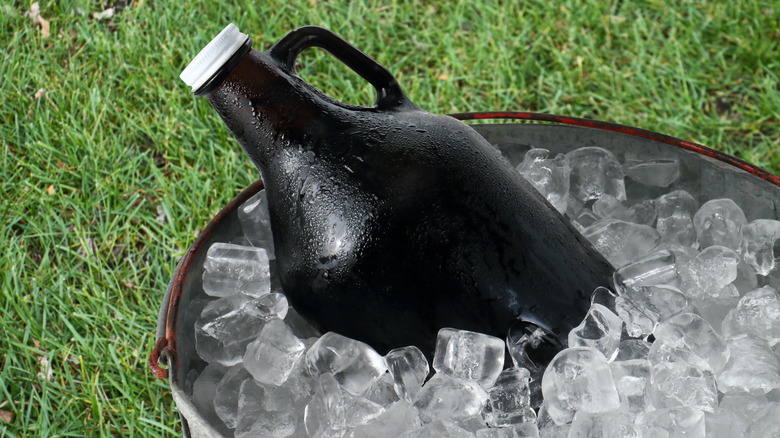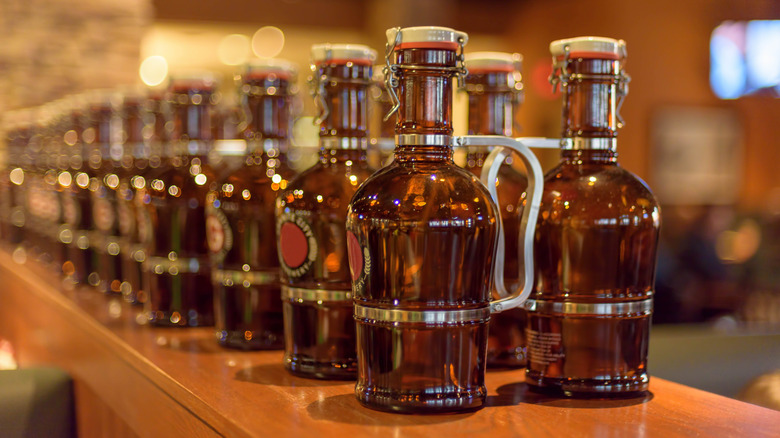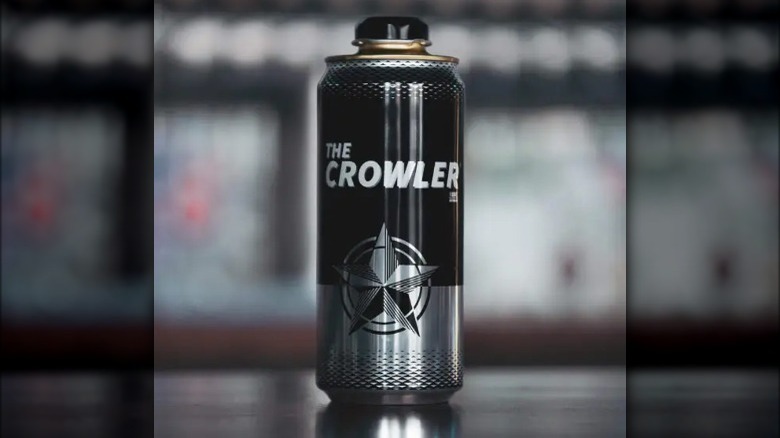What's The Difference Between Crowlers And Growlers Of Beer?
The beer landscape — especially that of craft beer — changes rapidly, and what's popular can vary regionally and seasonally. It's become commonplace to visit your favorite brewery and find a new slate of offerings each time you visit, a trend so pervasive that bartender-oriented Class pointed out it's unusual to be able to order a pint of the same beer you liked from a previous visit.
And it's not just the beer we drink that's evolved; the packaging shifts as well and is prompted by several factors. Beverage Journal traces some of the changes in beer packaging, from draft beer stored in wooden kegs that predated pressurized systems to stainless steel barrels that are easier to sterilize. Beer packaged in individual cans and bottles made it easier for consumers to purchase bevvies for consumption at home rather than at a pub, and developments like the pull tab meant you didn't even need a churchkey can opener to open those cans.
As craft breweries began to flourish, beer enthusiasts clamored for ways to enjoy that beer at home, but the cost of bottling, canning, and packaging lines may be out of reach for the smallest of operations (per Semcor). The solution: growlers and crowlers. But what's the difference between the two kinds of beer packaging?
Growlers come in two sizes and are reusable in glass and stainless steel
Growlers aren't actually a new phenomenon. The Growler Station explains that as far back as the late 1800s, thirsty folks would use metal buckets to transport beer from a bar to their homes for later consumption. Merriam-Webster shares that while there's plenty of speculation about where the name "growler" came from, there's not a single agreed-upon, definitive source or explanation of how the word came to refer to containers of beer.
It was in the 1980s that growlers were reborn, according to The Growler Station. In 1988, Charlie and Ernie Otto founded Otto Brothers' Brewing Company, known as Grand Teton Brewing, in Wyoming. They wanted a way for their customers to take beer home to enjoy later, so they reinvented the growler and chose a 64-ounce glass jug that can be sealed with a twist-on cap.
Many breweries like Stone Brewing have followed suit, creating reusable containers in both glass and stainless steel that can be customized with the brewery logo. This allows thirsty patrons to take and share draft beers without requiring the brewery to invest in a bottling or canning line. Punch notes that aside from the typical 64-ounce size, you may also be able to purchase a growler at 32 ounces.
Growlers can be a bit clunky to tote around, and once they're opened, the beer inside needs to be consumed within a day or two. This means you may need friends to help polish off the hefty amount of beer — unless you opt for a higher-tech option like the TrailKeg Growler, which features its own CO2 cartridge.
Crowlers come in a one-size recyclable can to take on the go
It was Colorado-based Oskar Blues Brewing that developed the crowler in 2015 in cooperation with the Ball Corporation as a recyclable alternative to the growler, according to Pack Leader USA. If you want to fill your growler at a brewery, you have to remember to bring it along or buy a new one, but crowlers (a mashup of "can" and "growler") don't require consumer forethought.
Single-use crowlers — along with the equipment used to seal them — allow breweries, taprooms, and retailers with draft systems to sell fresh beer to go that's sealed in a 32-ounce recyclable can. One drawback of crowlers is that once you open them, the beer needs to be consumed that day. However, Oskar Blues and Crowler Nation, a manufacturer and retailer of crowler equipment, have subsequently created the Twistee Can, which doesn't require a can seamer and uses a twist-on cap that consumers can remove and replace to keep their beer fresh a bit longer, per Westword.
While crowler can seamers do require an investment from the brewery, it's a solution that Westword points out allowed small businesses to stay afloat when they could only sell beer to go during the pandemic. So when it comes down to it, growlers and crowlers give craft beer enthusiasts flexibility to enjoy brewery-fresh pours at their leisure and at home — just in different amounts and packaging.


